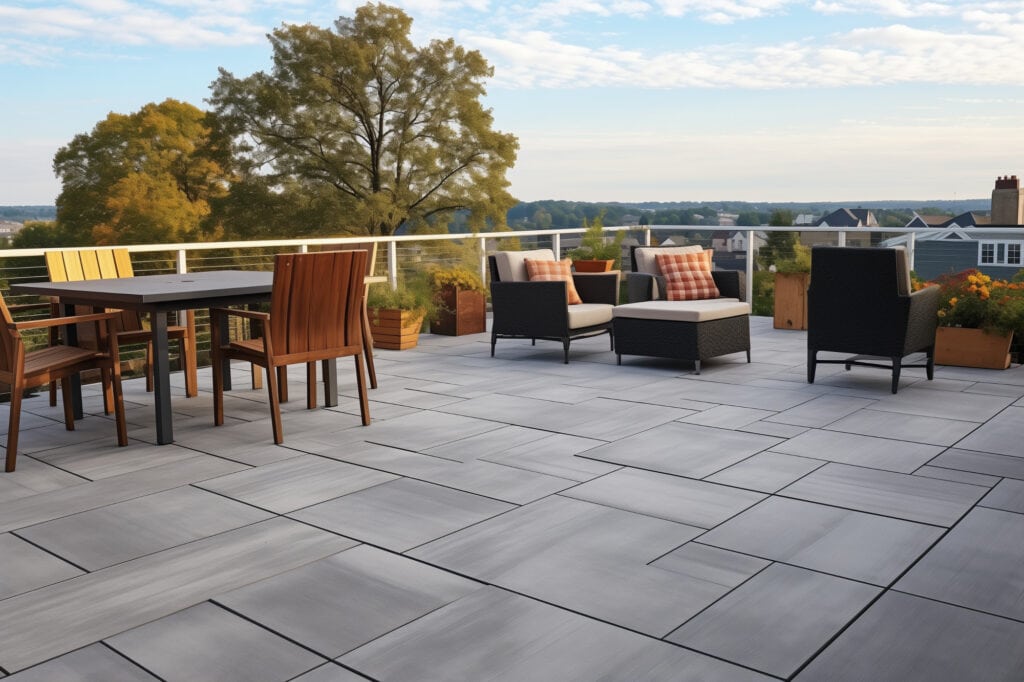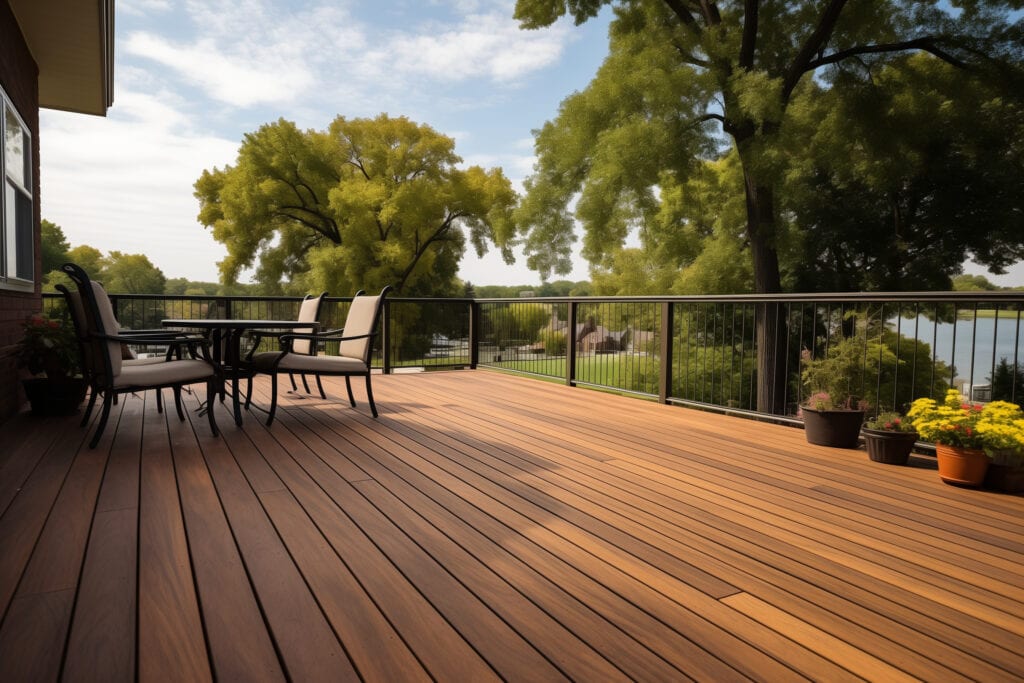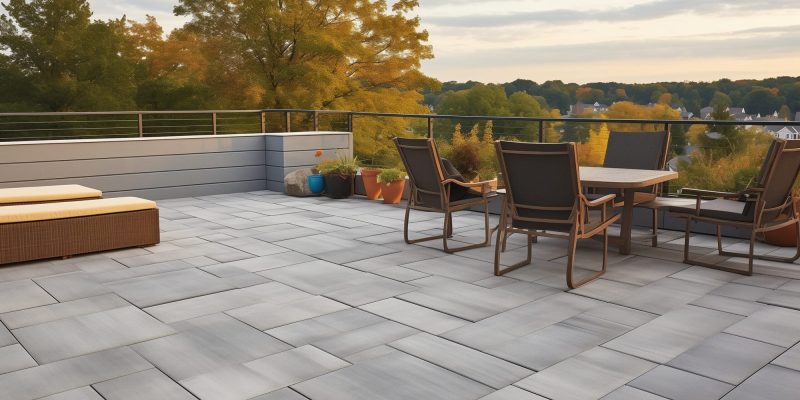Dreaming of expanding your backyard living space for entertaining or just enjoying peaceful mornings with coffee? One of the most critical decisions you’ll need to make early on is choosing between a durable, long-lasting concrete deck or a classic wooden deck.
Both options come with tradeoffs when it comes to appearance, overall durability, long term maintenance costs, and handling Iowa’s punishing seasonal climate shifts from blistering summers to frigid, snowy winters. Continue reading as I elaborate extensively on the pros, cons, costs, and considerations of concrete and wood decks to fully assist you in determining the optimal material option for upgrading your property!
The Structural and Low Maintenance Benefits Concrete Decks Provide

Installing a properly reinforced and poured concrete deck by experienced contractors using high quality finishing and sealing products can result in it easily retaining sturdiness and visual appeal for 30-50 years with very few structural cracks or stains needing repairs down the road.
Strength and Durability
The dense concrete material when mixed to specifications strongly resists minor cracking, surviving hundreds of winter freeze/thaw cycles, preventing weed growth, insect nesting, and much more. This also means you’ll encounter fewer safety issues that require expensive fixes over the decades of use a quality concrete build will provide. What’s more, the absence of nails, splinters, and wood rot makes concrete decking a safer choice for households with small children who will be playing outdoors frequently.
Additionally, concrete requires no tedious annual restaining, power washing or resealing to maintain its like-new appearance and prevent degradation the way wood decking does year after year. Just occasional quick sweeping or hose washing followed by a fresh concrete sealer application every 3-5 years is all that’s needed!
And minor control joints, saw lines, and surface cracks that develop can usually be patched and filled relatively effortlessly as compared to replacing whole warped, moldy wooden deck planks.
Furthermore, strong Midwest thunderstorms with intense winds, heavy snow and ice buildup and even ground shifting rarely impacts reinforced concrete’s underlying sturdiness. The dense surface also resists forming splinters and cracks the way decades of extreme Iowa weathering degrades most wood decking over the years. The inherent durability of concrete construction makes it well equipped to withstand years, even decades of punishing seasonal climate conditions in Des Moines without developing structural deficiencies or safety hazards.
Customization Options
An exciting benefit is custom concrete decks can be beautifully integrated with existing concrete patios. The ability to customize new deck pours with any variety of color tints for a uniform appearance, intricate artistic stamping designs, varied broom finishes or exposed aggregate stone textures and multi-level tiers completely unique to each homeowner’s personal vision simply has no rival in what natural wood staining can reasonably achieve aesthetically. The possibilities are truly endless when you utilize concrete construction to enhance backyard spaces!
The Higher Initial Cost Disadvantage of Concrete Installation
While substantial lifelong savings on outdoor flooring maintenance costs and youthful aesthetics for decades constitutes a massive value advantage, the initial installation expense of properly reinforced and finished poured concrete does admittedly run notably higher than pressure treated wood construction. However, when weighing overall durability, safety, longevity of service and the increased resale property value quality concrete decking contributes versus a aging, splintered wood deck needing constant refurbishment, concrete becomes quite competitive in cost-per-year comparisons.
Additionally, despite the very best concrete mix designs and steel reinforcement planning, concrete does gradually exhibit cracking over decades of freeze/thaw exposure, seasonal soil shifting and typical use. However, these cracks are mostly minor cosmetic markings within anticipated control joints and do not indicate structural deficiency. They can also be quickly patched and filled every few years as needed which is far simpler and cheaper than replacing whole rotten, warped planks of natural wood decking.
One other downside is that on hot sunny summer afternoons, the concrete mass absorbs thermal heat and releases it slowly over hours longer into the evenings than wood remains warm under bare feet. So if using the space for extended periods during July and August heat waves, wood decking’s breathability offers noticeably more comfort and cooler underfoot contact temperature once the sun goes down. Fortunately, creative shade structures can easily remedy concrete’s extra heat soaking when needed.
Finally from a construction perspective, altering or modifying an existing concrete deck’s layout after the initial pouring and forming process has cured and hardened does become complicated in short order. Making decorative or functional layout changes to simpler wood deck designs in the coming years remains far more feasible by comparison. So concrete’s permanency must be planned for up front.
The Natural, Nostalgic Charm and DIY Value of Classic Wooden Decks

Despite innovative modern decking products, there’s no denying the enduring visual charm and nostalgic personality of natural wood grains, knots, and inherent textures. For many Des Moines homeowners favoring a cozy, traditional aesthetic ambiance over sleek, contemporary concrete living spaces, pressure treated lumber remains a fantastic deck building material option.
Basic pressure treated wood keeps installations quite affordable in comparison to poured concrete options. Or, higher end exotice tropical hardwoods or meticulously crafted cedar planks raise the aesthetic depth and value considerably. Additionally, composite decking lumber products cost moderately more than basic pressure treated construction grade boards yet promise exceptional decades-long durability, dimensional stability and integrated fade, mold and insect resisting qualities with far fewer yearly maintenance hassles.
DIY enthusiasts possessing fundamental carpentry skills can often successfully tackle wood deck construction solo over a few weekends without needing to hire out for expensive concrete finishing crews. This do-it-yourself factor can make wood decking quite appealing. Just be sure to pull required permits and have the city inspect the framework and railing installations.
An inherent advantage to wood’s natural breathability is that decks constructed properly to allow adequate airflow stay up to 20% cooler on sweltering hot Midwestern days in July and August. This noticeable temperature difference goes a long way towards comfortable barefoot enjoyment compared to blistering concrete. Additionally, replacing a few warped cedar planks or reconfiguring the deck stairs to match evolving backyard uses over the years remains relatively simple with wood’s modular layouts.
And gorgeous natural wood grains paired with the subtle imperfections and uniqueness of no two planks being identical imparts an aged, nostalgic personality and organic glow that no human fabricated concrete slab can ever fully replicate. There is an undeniable, enduring charm to wood that concrete may never possess.
The Continuous, Demanding and Costly Maintenance Burden Associated with Natural Wood Decking
However, the growing shift towards low maintenance composite and PVC decking alternatives or elegantly formed concrete should signal that living with real timber surfaces introduces some genuine practical downsides many homeowners fail to adequately plan for.
Maintaining the ongoing surface integrity and structural stability of wood requires committing to tedious annual restaining/sealing, frequent mold inhibiting power washing, vigilant splinter and nail pop inspections and occasional crack/sag repairs to sustain safety and prevent premature deterioration a few years down the road. Make no mistake, real wood demands consistent upkeep efforts to delay the inevitable decay processes from diminishing its lifespan.
Frigid Midwestern winter deep freezes, heavy snow loads and repeated blizzard storm cell wind gusts inevitably extract a gradual toll on even sturdy cedar or treated wood infrastructure. Over years of exposure, this manifests through splintering deck planks, pronounced warping, surface fungi formation and accelerated structural deficiencies necessitating periodic partial refurbishment. If neglected, potentially costly full deck replacements become imminent.
What’s more, wood boring carpenter bees, termites, and ants are magnetically attracted to untreated wooden deck framing and exposed plank ends as an all-you-can-eat breeding buffet. Their nest excavating and tunneling infestations can severely compromise support integrity. Therefore vigilant pest prevention inspections and treatment methods are vital for protecting wood deck investments against preventable insect devastation risks.
Key Considerations for Determining the Superior Backyard Deck Material
When weighing the decision between natural wood versus concrete deck construction, start by thoroughly assessing your family’s personal aesthetic preferences, intended backyard functional uses, tolerance willingness to take on intensive annual sealing/cleaning maintenance, accurately comparing long term cost-per-year projections, and objectively determining whether real wood or modern concrete best withstands Iowa’s punishing seasonal climate extremes through the decades.
Seeking 3rd party professional design input upfront and planning budgets for proper construction permitting/inspections is highly advisable as well before finalizing your backyard upgrade visions. Please feel free to contact me anytime for detailed concrete quotes or a free one-on-one, no obligation backyard living space consultation! I’m happy to explore every option imaginable.
In Conclusion, Evaluate All Variables Carefully Before Proceeding
Whether you eventually elect to install timeless rich cedar wood decking or smooth, modern low-maintenance concrete as the ideal backyard living expansion option, carefully weighing the variables I’ve covered will undoubtedly assist in determining the optimal long term solution avoiding future regrets.
Review all the comprehensive pros, cons and comparative factors between construction materials and installation considerations covered here when aligning your final decision with family practical needs and lifestyle expectations for maximum enjoyment decades into the future.
Please reach out anytime to request a personalized quote for your property goals or just to further discuss best possibilities moving ahead. I eagerly look forward to collaborating on conceptualizing your ideal backyard leisure space this coming season!

